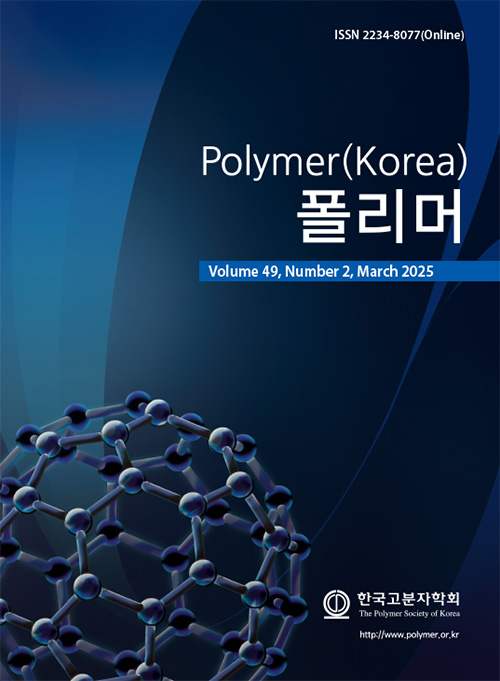- Influence of Water Content on the Structural Evolution of PA6 Cast Film During Stretching Uniaxial Process
*Chongqing Industry Polytechnic College, Chongqing 401120, China
**State Key Laboratory of Polymer Materials Engineering, Polymer Research Institute of Sichuan University, Chengdu 610065, China- 일축 인장 공정 중에서 PA6 주조 필름의 수분 함량이 구조적 변화에 미치는 영향
Reproduction, stored in a retrieval system, or transmitted in any form of any part of this publication is permitted only by written permission from the Polymer Society of Korea.
In this study, the diffusion process of water molecules in polyamide 6 (PA6) films was investigated using time-dependent infrared spectroscopy. PA6 films with different water contents were prepared, and the influence of water on microstructure of PA6 was investigated using thermogravimetric analyzer (TGA), X-ray diffraction (XRD) and differential scanning calorimetry (DSC). PA6 films with different water contents were stretched to different strains, and DSC, XRD, polarized infrared spectroscopy and 2D-SAXS were used to investigate the structural evolution of these samples during stretching. Results revealed that the diffusion of water molecules in PA6 film disrupts the hydrogen bonding between PA6 molecular chains and weakens the interactions between PA6 molecules. The difference in water content leads to differences in the initial state of the PA6 films. Higher water content PA6 films exhibit lower glass transition temperature, improved molecular chain mobility, lower elastic modulus and lower yield strength on the stress-strain curve. The presence of water enhances the molecular chain mobility of PA6 and slows down the rate of crystalline orientation along the stretching direction. At the same stretching ratio, the crystallinity and orientation degree of high water content samples are always lower than those of dry samples. At the same time, the stretching deformation process of PA6 is accompanied by γ→α phase transition: the interaction between molecules in samples with high water content is weak, and the molecular chain segments have better mobility. Its degree of phase transition that occurs during the stretching process is also higher. During the uniaxial stretching process, PA6 samples with different water contents exhibit the same trend: before the strain reaches 50%, the long period of the sample gradually increases, mainly due to the crystalline orientation along the stretching direction under tensile stress and the gradual extension of molecular chains in the amorphous region. At higher strain, the long period of all three samples decreased mainly due to the shear, slip, and fragmentation of the crystals under tensile stress, resulting in the formation of smaller crystal sizes. During the uniaxial stretching process, PA6 samples with high water content exhibit longer crystalline long period along and perpendicular to the stretching direction. This is due to their strong molecular chain segment mobility, resulting in a more relaxed structure that is more suitable for biaxial stretching.
Keywords: polyamide 6, uniaxial stretching, plasticizer, structure evolution.
- Polymer(Korea) 폴리머
- Frequency : Bimonthly(odd)
ISSN 2234-8077(Online)
Abbr. Polym. Korea - 2024 Impact Factor : 0.6
- Indexed in SCIE
 This Article
This Article
-
2025; 49(2): 222-235
Published online Mar 25, 2025
- 10.7317/pk.2025.49.2.222
- Received on Oct 10, 2024
- Revised on Nov 25, 2024
- Accepted on Dec 4, 2024
 Correspondence to
Correspondence to
- Yi Zhang
-
*Chongqing Industry Polytechnic College, Chongqing 401120, China
**State Key Laboratory of Polymer Materials Engineering, Polymer Research Institute of Sichuan University, Chengdu 610065, China - E-mail: nsno1@163.com









 Copyright(c) The Polymer Society of Korea. All right reserved.
Copyright(c) The Polymer Society of Korea. All right reserved.